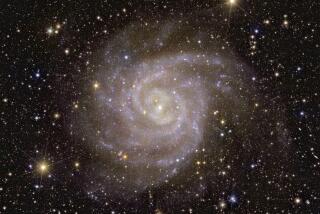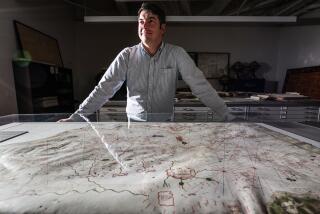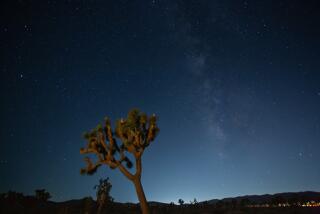A Stargazer’s Guide to the Universe
- Share via
Since we’ll be putting a large telescope in space, it will have to be able to recognize the stars it is viewing. To achieve that, scientists at the Space Telescope Science Institute in Baltimore produced, in 1989, the largest star map ever made.
Star maps have a long history. The first important one was prepared by the ancient Greek astronomer, Hipparchus, about 130 BC. He had spotted a new star in the sky (something we call a nova nowadays), and he wanted to make sure that other such phenomena would be quickly recognized. To do that, he listed the 850 brightest stars and gave their positions by dividing the sky into lines of latitude and longitude.
About AD 150, another astronomer, Ptolemy, incorporated Hipparchus’ data into his own book on the subject and added 170 stars. Ptolemy’s map was used for 14 centuries. In the 1580s, however, the Danish astronomer, Tycho Brahe, prepared the first modern star map. His map included 788 precisely located stars.
A century later, in 1661, a sharp-eyed German astronomer, Johannes Hevelius, prepared a map containing 1,564 stars, one that was even better than Brahe’s.
After Hevelius’ time, stars were mapped only with the use of the telescope. With the telescope it was also possible to see and locate stars too dim for the unaided eye to discern. The first telescopic star map of importance was prepared by an English astronomer, John Flamsteed. The map was published in 1725, six years after Flamsteed’s death, and it listed 3,000 stars.
Between 1859 and 1862, however, making use of far better telescopes, the German astronomer, Friedrich Argelander, prepared a giant map of the stars, cataloguing no fewer than 457,848 of them in four large volumes, each star carefully listed by latitude and longitude.
Once it became possible to photograph the night sky through large telescopes, it was no longer necessary to work out the position of each star while observing. By the early 1900s it was possible to map millions of stars.
The 1989 map prepared by the Space Telescope Science Institute catalogues the position and brightness of 18,829,291 objects. Of these about 15 million are stars in our own galaxy. The remaining 3 million to 4 million are other galaxies.
Humans with good vision can only see about 6,000 stars unaided by optics. These go down to the 6th magnitude in brightness. (The higher the magnitude, the dimmer the star). The 1989 map contains all the stars and other objects down to the 15th magnitude. But modern telescopes can make out objects to the 21st magnitude, so the new star map does not include every visible object by any means.
One would think that no flaws could be found with such a enormous and accurate star map, but the fact is that all stars move. They are plunging along huge orbits that carry them about the center of the galaxy, some in fairly circular orbits and some in elongated elliptical orbits.
The motions are very slow, but they represent shifts in position that, while tiny, will certainly throw off the Space Telescope. In only five years, astronomers estimate, fully 10% of the stars will have shifted position sufficiently for the Space Telescope not to be able to recognize them.
What astronomers are now doing, therefore, is calculating these apparent motions so that they can incorporate that information in the star map.






